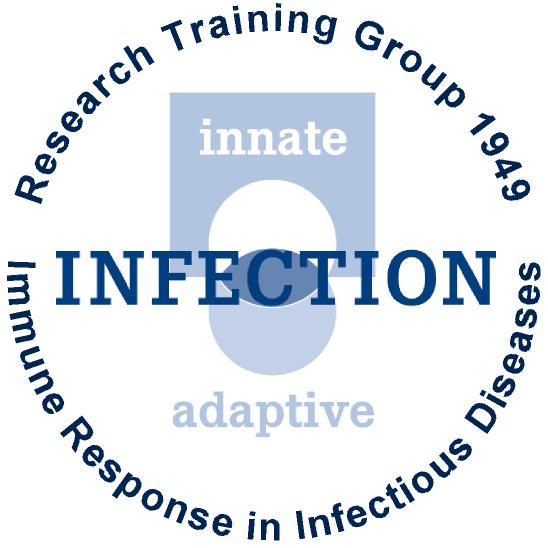Project area I - Project 2 - Carsten Kirschning
Principal Investigator:

Prof. Dr. rer. nat. Carsten Kirschning
Institute of Medical Microbiology
University Hospital Essen
University of Duisburg-Essen
carsten.kirschning@uk-essen.de
Phone: +49 201 723 1824
Analysis of rapid IFNγ production of NK cells towards
adaptive immunity and anti-bacterial activities of
macrophages early upon bacterial infection
Already within the first 2 hours of infection, Gram-negative bacterial infection drives NK and NKT cell production of IFNγ via Toll-like receptor (TLR) 4 activation. IFNγ primes a TLR2 contribution to pathogen sensing and sepsis pathology. Accordingly, Gram-negative bacteria fail to induce IFNγ production in Tlr4-/- mice, in which TLR2 activity is undetectable. Hence, an IFNγ dependent innate immune program governing sequential activation of TLR4 and TLR2 is operative. For Gram-positive bacterial infection sensing in which TLR4 is not involved, an analogous IFNγ/TLR2 triggering molecule is elusive and a matter of this proposal. Since mouse (m) TLR13 and human (h) TLR8 dominate Gram-positive bacteria sensing and their activity modulation correlates with IFNγ production by splenocytes and PBMCs, mTLR13 and hTLR8 are good candidate molecules.
Moreover, we observed a TLR dependent release of an unidentified and effective bactericidal activity expression, which is induced upon Gram-positive bacterial infection. Our second aim is thus the identification of the responsible anti Gram-positive bacterial effector molecule.
Mice lacking expression or at least function of specific TLRs (e.g. of 3d/Tlr245-/- and Tlr2/13-/- strains) as well as purified pathogen associated molecular patterns (PAMPs) derived of Gram-positive bacteria will be used to identify the PRR and its cognate ligand PAMP, which mediate NK and NKT cell IFNγ production and thus priming of TLR2. Additionally, we aim at identifying a TLR driven anti Gram-positive bactericidal macrophage peptide applying transcriptome profiling and mass spectrometric analyses.
Publications
Krüger A, Oldenburg M, Chebrolu C, Beisser D, Kolter J, Sigmund AM, Steinmann J, Schäfer S, Hochrein H, Rahmann S, Wagner H, Henneke P, Hornung V, Buer J, Kirschning CJ. Human TLR8 senses UR/URR motifs in bacterial and mitochondrial RNA. Embo reports. 2015 Nov 6;10.15252/embr.201540861.
Fieber C, Janos M, Koestler T, Gratz N, Li XD, Castiglia V, Aberle M, Sauert M, Wegner M, Alexopoulou L, Kirschning CJ, Chen ZJ, von Haeseler A, Kovarik P. Innate immune response to Streptococcus pyogenes depends on the combined activation of TLR13 and TLR2. PLoS One. 2015 Mar 10;10(3):e0119727.
Khairnar V, Duhan V, Maney SK, Honke N, Shaabani N, Pandyra AA, Seifert M, Pozdeev V, Xu HC, Sharma P, Baldin F, Marquardsen F, Merches K, Lang E, Kirschning C, Westendorf AM, Häussinger D, Lang F, Dittmer U, Küppers R, Recher M, Hardt C, Scheffrahn I, Beauchemin N, Göthert JR, Singer BB, Lang PA, Lang KS. CEACAM1 induces B-cell survival and is essential for protective antiviral antibody production. Nat Commun. 2015 Feb 18;6:6217.
Knuschke T, Bayer W, Rotan O, Sokolova V, Wadwa M, Kirschning CJ, Hansen W, Dittmer U, Epple M, Buer J, Westendorf AM. Prophylactic and therapeutic vaccination with a nanoparticle-based peptide vaccine induces efficient protective immunity during acute and chronic retroviral infection. Nanomedicine. 2014 Nov;10(8):1787-98.
Oldenburg M, Kruger A, Ferstl R, Kaufmann A, Nees G, Sigmund A, Bathke B, Lauterbach H, Suter M, Dreher S, Koedel U, Akira S, Kawai T, Buer J, Wagner H, Bauer S, Hochrein H, Kirschning CJ. TLR13 recognizes bacterial 23S rRNA devoid of erythromycin resistance-forming modification. Science. 2012;337:1111-5.
Conrad ML, Ferstl R, Teich R, Brand S, Blümer N, Yildirim AO, Patrascan CC, Hanuszkiewicz A, Akira S, Wagner H, Holst O, von Mutius E, Pfefferle PI, Kirschning CJ, Garn H, Renz H. Maternal TLR signaling is required for prenatal asthma protection by the nonpathegenic microbe Acinetobacter Iwoffii F78. J Exp Med. 2009;206:2869-77.
Spiller S, Elson G, Ferstl R, Dreher S, Mueller T, Freudenberg M, Daubeuf B, Wagner H, Kirschning CJ. TLR4-induced IFN-gamma production increases TLR2 sensitivity and drives Gram-negative sepsis in mice. J Exp Med. 2008;205:1747-54.
Spiller S, Dreher S, Meng G, Grabiec A, Thomas W, Hartung T, Pfeffer K, Hochrein H, Brade H, Bessler W, Wagner H, Kirschning CJ. Cellular recognition of trimyristoylated peptide or enterobacterial lipopolysaccharide via both TLR2 and TLR4. J Biol Chem 2007;282:13190-8.
Heil F, Hemmi H, Hochrein H, Ampenberger F, Kirschning C, Akira S, Lipford G, Wagner H, Bauer S. Species-specific recognition of single-stranded RNA via toll-like receptor 7 and 8. Science. 2004;303:1526.
Meng G, Rutz M, Schiemann M, Metzger J, Grabiec A, Schwandner R, Luppa PB, Ebel F, Busch DH, Bauer S, Wagner H, Kirschning CJ. Antagonistic antibody prevents toll-like receptor 2-driven lethal shock-like syndromes. J Clin Invest. 2004;113:1473-81.


